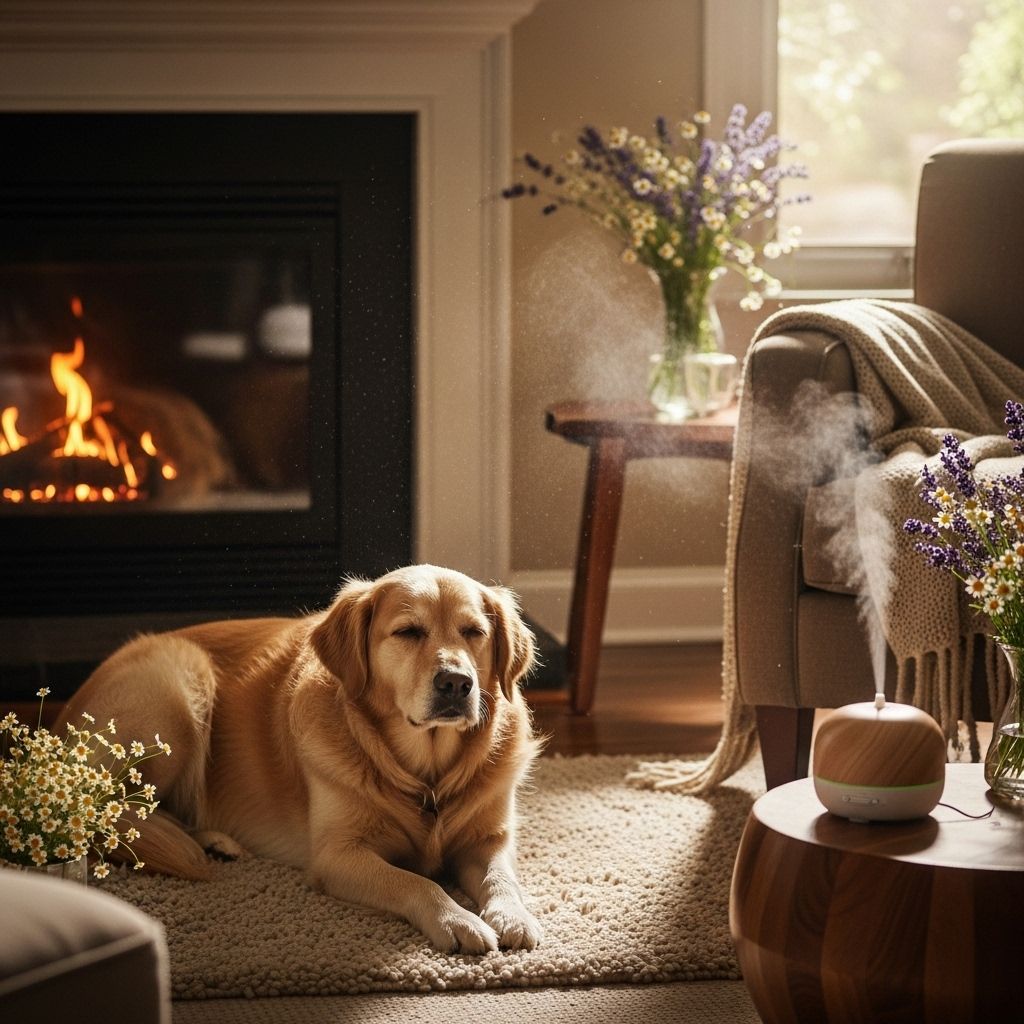Natural Home Remedies for Separation Anxiety in Dogs
Learn gentle, effective, and evidence-based strategies to ease your dog's separation anxiety naturally at home.

Separation anxiety is a common behavioral challenge among dogs, manifesting as distress or destructive behaviors when left alone. While conventional medication can help severe cases, many pet owners seek natural, gentle alternatives for managing their dog’s anxiety in the comfort of their own home. This comprehensive guide explores science-backed, practical home remedies and calming techniques for easing canine separation anxiety, ensuring a happier, healthier life for both dog and owner.
Understanding Separation Anxiety in Dogs
Separation anxiety occurs when a dog experiences extreme distress after being separated from their primary caregivers. Typical behaviors include:
- Excessive barking, whining, or howling
- Pacing or restlessness
- Destructive actions (chewing, digging, scratching doors or windows)
- House soiling (urinating or defecating indoors)
- Drooling or panting
- Attempts to escape confinement areas
Addressing this problem early is crucial for your pet’s wellbeing and your household’s harmony. Tailoring natural remedies to your dog’s individual needs, guided by a professional when necessary, can make a significant difference in their anxiety levels.
Core Natural Remedies and Calming Strategies
1. Exercise and Physical Activity
Regular exercise is one of the most effective, drug-free ways to relieve anxiety in dogs. Physical activity helps to burn off excess energy, reduce nervous tension, and stimulate the production of mood-boosting chemicals like serotonin. Prior to leaving home, ensure your dog has a brisk walk or engaging play session. Consider the following options:
- Long walks or jogs in a new environment
- Games of fetch or tug-of-war
- Agility exercises or obedience training drills
- Puzzle toys that release treats
Consistent exercise routines can minimize restlessness and destructive behaviors by providing both mental and physical stimulation.
2. Behavioral Training Techniques
Overcoming separation anxiety often requires targeted behavior modification. Key methods include:
Counterconditioning
This technique transforms a stressful experience into a positive one by pairing your absence with something your dog loves, such as high-value treats or favorite toys. For example, provide a KONG toy stuffed with peanut butter, canned dog food, or another irresistible filling right before you leave. Remove the toy as soon as you return, so your dog only associates it with your absence. With time, your dog will begin to anticipate good things when home alone. This is especially useful for mild anxiety cases and should be used consistently.
Desensitization
Gradually accustom your dog to being left alone through stepwise departures. Practice your pre-departure cues (putting on shoes, picking up keys) without actually leaving, or leave for very short periods before returning. Gradually extend your absence as your dog becomes more comfortable. Avoid dramatic departures and greetings, as these reinforce anxious behavior.
Promoting Independence
- Encourage your dog to spend short periods in a separate room while you are still at home
- Reward calm, independent behaviors with praise or treats
- Minimize constant petting or reassurance, which may reinforce anxiety
3. Safe Spaces and Environmental Comfort
Creating a safe, inviting environment can help your dog associate your absence with comfort and security. Consider the following tips:
- Crate Training: A properly introduced crate can function as a den—a personal, safe retreat. Gradually acclimate your dog to the crate using treats, toys, and calm encouragement, never using it for punishment.
- Comforting Items: Leave an item with your scent (unwashed t-shirt, blanket) in your dog’s resting area
- Cozy Beds: Provide a comfortable, familiar bed in a quiet, low-traffic area of the home
4. Calming Music and Audiobooks
Soothing background noise can mask environmental triggers (such as traffic or neighbor noise) and create a calming backdrop for your dog when you leave. Try the following:
- Soft classical or acoustic music designed for pets
- Specially curated “dog radio” playlists
- Audiobooks featuring human voices for companionship
Research shows that music, played at low volumes, can reduce canine stress levels and promote relaxation.
5. Herbal Remedies and Supplements
Several gentle, natural supplements and plant-based compounds may help ease anxiety in sensitive dogs. Always consult your veterinarian before introducing new supplements. Common options include:
- CBD Oil: Cannabidiol (CBD), derived from hemp, is widely used as a calming supplement. Preliminary studies and anecdotal reports suggest it may reduce anxiety and promote relaxation, but quality and safety must be confirmed. Use only veterinary-approved products.
- Chamomile, valerian root, and passionflower: These herbs are known for their mild sedative effects and are sometimes found in veterinary-formulated treats or tinctures.
Table: Natural Supplements and Their Reported Benefits
| Supplement | Source | Potential Benefit | Safe Usage |
|---|---|---|---|
| CBD Oil | Hemp | Calming, may reduce anxiety | Use vet-approved, start with low dose |
| Chamomile | Flower | Mild sedation, relaxation | Safe in vet-formulated doses |
| Valerian Root | Root | Sedative, may aid sleep | Short-term use, check interactions |
| Bach Flower Rescue Remedy | Blend of flowers | Emotional balance, stress relief | Safe, non-toxic, vet guidance |
6. Aromatherapy and Flower Essences
Certain scents and flower extracts can create a calming environment for anxious dogs. Always use pet-safe, diluted formulations and avoid direct application to your dog’s skin.
- Essential Oils: Lavender, violet leaf, and Roman chamomile oils can be calming when used in a diffuser or diluted spray.
- Bach Flower Remedies: The Rescue Remedy blend is popular for acute stress and can be administered in water or gently massaged onto your dog’s ears or paws.
- Hydrosols: Less concentrated than oils, hydrosols (such as chamomile or lavender hydrosol) are safer and can be misted in your dog’s environment.
Caution: Never allow dogs to ingest essential oils or use undiluted oils directly on their skin.
7. Weighted Blankets and Anxiety Wraps
Weighted blankets and snug-fitting anxiety wraps (like the Thundershirt) provide gentle, constant pressure, which can soothe the nervous system and promote a sense of security during stressful times such as departures or storms.
8. Establishing Predictable Routines
Consistent daily routines help reduce anxiety by providing structure and predictability. Key ways to foster routine include:
- Regular feeding and exercise schedules
- Consistent departure cues and calm departures
- Short, calm returns without excessive excitement
Additional Natural Techniques and Lifestyle Changes
Positive Reinforcement Training
Reward calm, independent behaviors with treats, praise, or favorite toys. Avoid punishing anxious behaviors, as this may worsen your dog’s distress.
Tactile Comfort
- Gentle petting or brushing can relax some dogs before departure
- Massage therapy may reduce arousal and stress for touch-loving dogs
Distraction Techniques
- Leave treat puzzles or interactive feeders to keep your dog engaged and mentally stimulated while you are away
- Rotate toys regularly to maintain interest
Professional Support
- Consult a certified canine behaviorist or positive reinforcement trainer for severe or persistent cases
- Veterinary consults are important to rule out medical causes of anxious behavior
Frequently Asked Questions (FAQs)
Q: How do I know if my dog has separation anxiety versus just being bored?
A: Dogs with separation anxiety show signs of distress like destructive behavior, vocalizations, and house soiling only or mostly when left alone, not during normal play or rest. Boredom usually leads to lower intensity behaviors and does not cause marked distress when the owner leaves.
Q: Can essential oils be harmful to dogs?
A: Yes, concentrated essential oils can be toxic if ingested or applied directly to skin. Always use veterinary guidance, choose dog-safe oils (like lavender), dilute appropriately, and ensure your dog can leave the area if the scent is bothersome.
Q: Is it safe to leave my dog in a crate to prevent separation anxiety?
A: Crates can be a helpful tool if introduced positively. They should never be used as punishment, and dogs should always associate the crate with comfort and security. For some dogs, confinement may worsen anxiety, so crate training must be gradual and monitored.
Q: What should I avoid doing if my dog suffers from separation anxiety?
A: Avoid punishing your dog for destructive behaviors, excessively reassuring or fussing during departures and arrivals, or abruptly locking your dog away without proper crate training.
Q: Are there any quick fixes for separation anxiety?
A: Lasting improvement requires time, patience, and consistent practice of behavior modification techniques. While calming aids can support your efforts, no remedy works overnight. Severe cases may require professional intervention.
Summary Table: Home Remedies for Canine Separation Anxiety
| Remedy | Main Benefit | How to Use |
|---|---|---|
| Exercise | Reduces excess energy and stress | Long walks, games, playtime before departures |
| Behavioral Training | Rewires anxious patterns | Counterconditioning, desensitization, positive reinforcement |
| Crate Training | Promotes a safe space | Gradual, positive introduction, never punishment |
| Aromatherapy & Bach Remedies | Soothes nervous system | Diffused pet-safe oils, flower essences in water or topical |
| Music | Masks triggers, calms anxiety | Low-volume classical or special playlists |
| Supplements (CBD, herbal) | Aids relaxation | Vet-approved dosages, natural chews, tinctures |
When to Seek Professional Help
While natural home remedies are highly effective for mild to moderate separation anxiety, persistent or severe anxiety may require additional intervention. If your dog shows signs of self-injury, persistent vocalization, or extreme distress, consult your veterinarian or a certified animal behaviorist for a tailored treatment plan, which may involve behavioral therapy or medication. Early intervention offers the best chance for long-term improvement and wellbeing.
Further Reading and Resources
- ASPCA: Separation Anxiety in Dogs
- PetMD: Natural Ways to Calm Your Dog
- Dog Behaviorist Directories and Training Resources
Through patience, understanding, and the consistent use of natural remedies, your dog can learn to feel safe and confident, even when left alone. For best results, combine several of the techniques discussed above to provide holistic comfort, and always prioritize your dog’s individual personality and needs.
References
- https://www.petmd.com/dog/general-health/how-to-calm-your-dog-naturally
- https://www.aspca.org/pet-care/dog-care/common-dog-behavior-issues/separation-anxiety
- https://www.dogsnaturallymagazine.com/6-natural-solutions-for-dog-anxiety/
- https://pmc.ncbi.nlm.nih.gov/articles/PMC7521022/
- https://www.petassure.com/maxscorner/natural-remedies-for-dog-anxiety/
- https://lolahemp.com/blogs/dog-health/treating-separation-anxiety-dogs
- https://www.youtube.com/watch?v=ark8anP3i5k
- https://www.webmd.com/pets/dogs-separation-anxiety
Read full bio of medha deb












